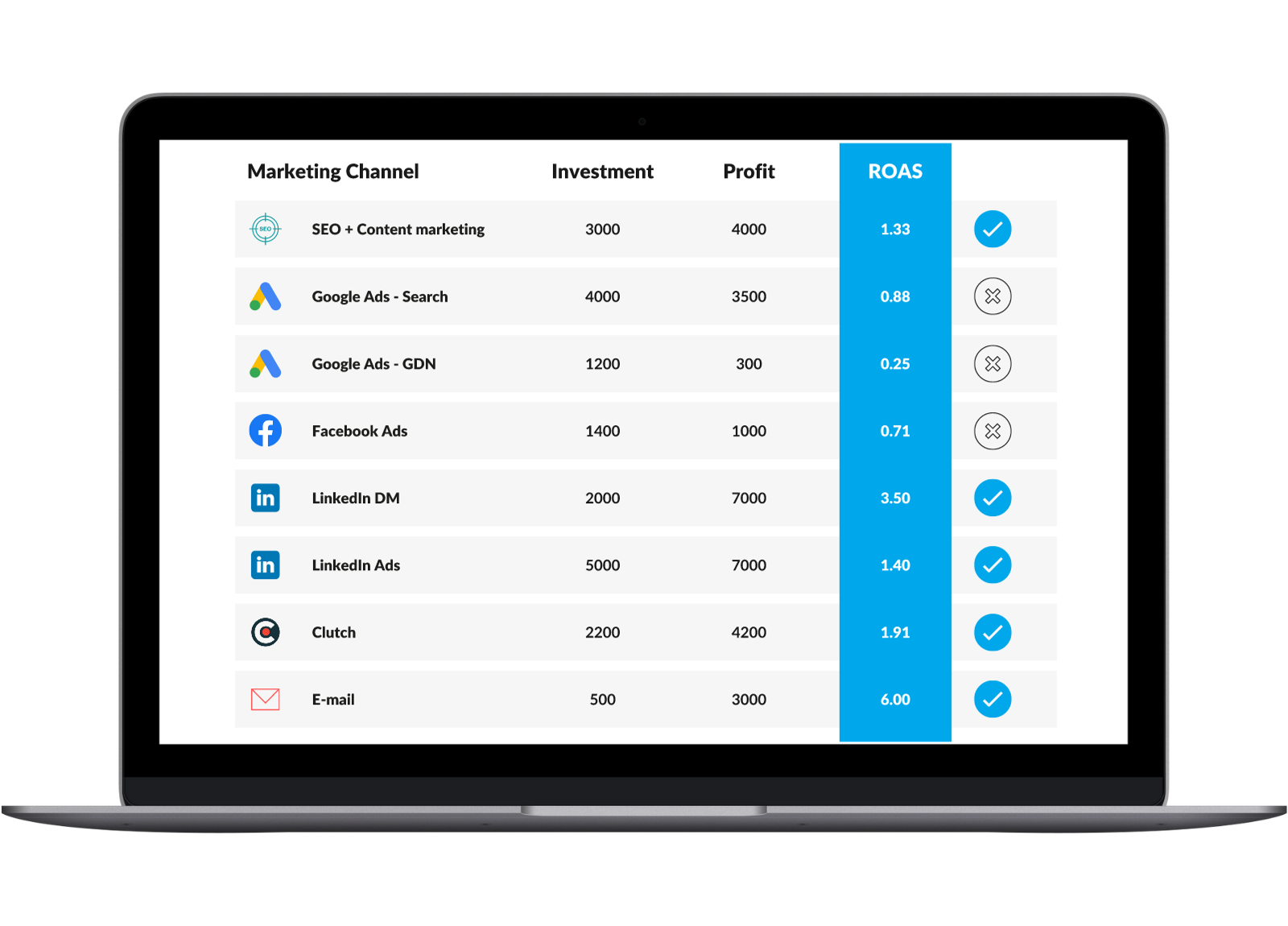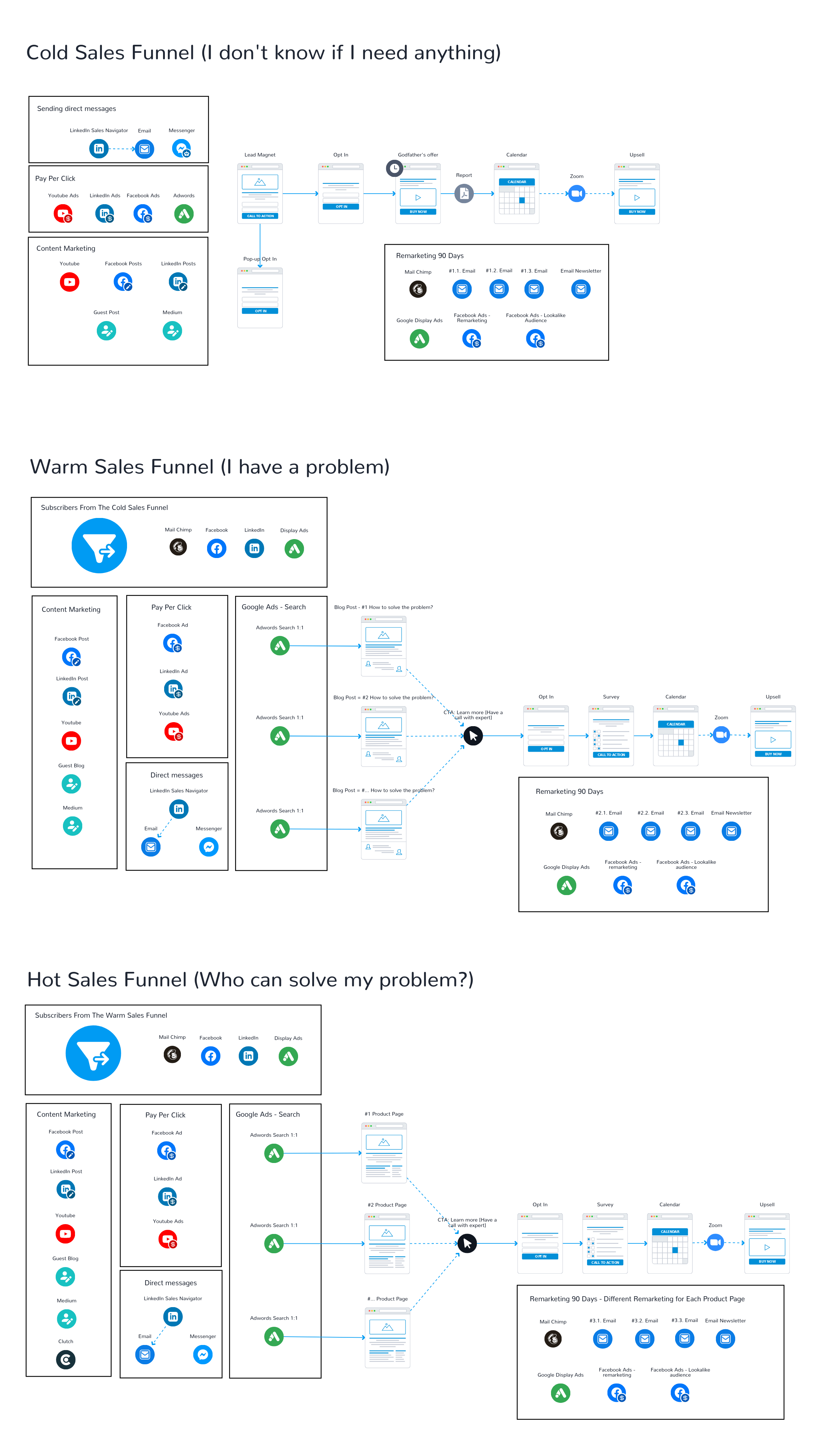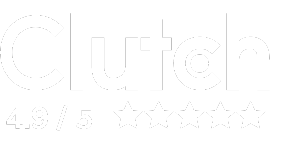The article is a summary of services provided in the field of digital marketing:
Million PLN revenue
for our customers
Years of
experience
Countries where
we conduct marketing activities
Satisfied
Clients
Our customers trust us with a total budget
90+ million PLN in marketing expenses.
From the article you will learn:
- What are the types of most effective marketing strategies today?
- ROAS
- Power Content
- Lead heating
- Sniper Landing Page
- Which marketing strategy should I choose for my business?
- How to implement a marketing strategy step by step?
Marketing strategy: ROAS
ROAS – return on ads spends — that is, return on investment in advertising.
The ROAS strategy consists of measuring the returns on investment in advertising, for individual marketing channels.
ROAS = profit / advertising costs
This strategy is based on the assumption that:
- Until we know which customer acquisition channels are profitable and which are not, we will never win in the market.
- The most important thing for a company is to find a business model that, with a certain investment in advertising, would generate a return. With a dollar investment, we get two. Then we become millionaires, because we move to scaling. Instead of spending $1,000 per month on advertising in Google Ads, we spend $100,000. We earn correspondingly more.
Simply put, we strive to obtain the data presented in such a table:
Where the rows present selected customer acquisition channels, and in the columns: channel name, investment – how much we spent on a given channel, and profit. In the last column is ROAS, i.e. the quotient: profit by costs.
Marketing channels that we can use as part of Digital Marketing activities are:
Social Media
- Running accounts in social media.
- DM campaigns via social media.
Email Marketing
- Email Marketing Automation.
Content Marketing
- E-Books.
- Whitepapers.
- Webinars.
- Videos.
- Blog Articles.
SEO
- On-site.
- Off-site.
PPC campaigns
- Google Ads: Search, Display, YouTube.
- Facebook Ads.
- LinkedIn Ads.
- Remarketing.
How to conduct an ROAS strategy?
For an effective ROAS marketing strategy, it is essential that it always starts with:
- Idea — as illustrated by the light bulb in the figure.
- Then, according to the agile method, we should proceed to implementation as soon as possible. In the classic approach, we would write a business plan of 200 pages. What it would take a quarter. Here we invest 1 day in creating a Lean Business Model Canvas. To focus on marketing / advertising activities as early as possible.
- Finally, we define the MVP — that is, the minimum value product — Minimum Viable Product. In other words: a product whose production consumes as little time and resources as possible, and represents USP/UVP – answers the question: what makes the product unique and worth buying. Next, we determine:
- Hypothesis — an affirmative sentence describing the future. Preferably in the form: measurable, set in time. For example: We will sell 20 software licenses by the end of the quarter.
- We conduct an experiment – we carry out the tasks set out in our plan exactly.
- Evaluation – we evaluate the effects and if we have received the expected return on investment, we scale. If we do not, we go back to defining the canvas of the business model and repeat the completed stages.
Basically, it’s about finding a USP for our product and testing it. This is where the real “artistry of marketing” begins.
You need to have an outstanding business sense to determine the answer to the question: what makes a product unique and worth buying?
Lean Business Model Canvas:
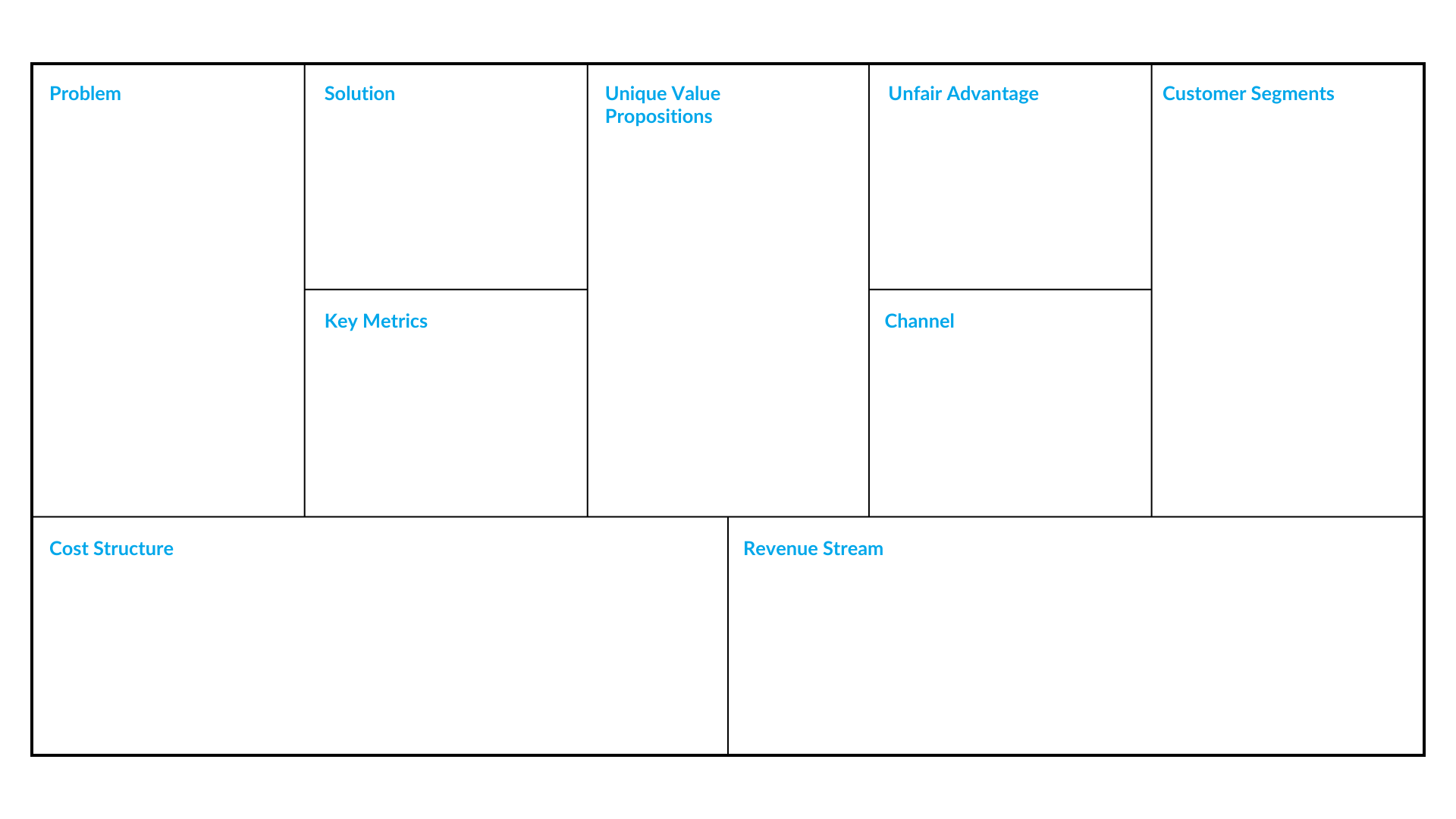
- Problem – what customer problem does our product/service solve? We list the most important three.
- Solution – what exactly will be the solution to this problem. We list three functionalities.
- USP (Unique Selling Proposition) / UVP (Unique Value Proposition) – what is the unique value/sales proposition of the product. We create a short, easy-to-understand message, answering the question: why is the product unique and worth buying?
- UA (Unfair Advantage) – what makes the product irreplaceable by competitive solutions.
- Segment – who will the product be prepared for, who is its recipient?
- Key indicators – how we will measure whether our product is attractive to customers. Most often it is profit, but it can also be: the number of users, the number of website views, etc.
- Channels – through which channels we will reach customers with information about the product.
- Income and costs
ROAS strategy will work best:
- For companies that do not know what else will work on the market and want to quickly find out whether:
- Their business model works.
- If so, for which marketing channels?
- Find out what message to put in which marketing channel so that there is a return on investment.
- For companies that have been operating for the last few years based on only one customer acquisition channel. These could be recommendations or running campaigns in Google Ads. Due to the change in the market situation, they are looking for new sales opportunities. Or they simply have an appetite for development — launching a new product on the market.
- This strategy works particularly well for industries where most promotions take place on the Internet, as for companies: IT & Software.
- For a medium-sized IT & Software company, experimenting on a business model in most channels should take no more than three months. In our experience, it is optimal to invest 80 hours of work per month. In addition, promotional expenses should also be taken into account if paid channels are selected. Here it is difficult to predict the price of the promotion – because clicking on the keyword “software house” in the United States can cost up to 50 PLN.
The results of our experience in working for companies from the IT & Software industry show such average results of ROAS indicators for individual marketing channels:
Marketing strategy: Power Content
Power Content – Search for video that will grab customers’ attention.
This strategy is based on the assumption that:
- Customers do not buy from us because they do not know about our product. So the most important thing is to inform them about our offer. And the cheapest way to do this is to buy advertising on social media — set to maximize impressions.
- In addition, we must inform about our offer in such a way that potential customers “fall hats off their heads”. To do this, you need to create a brilliant video — power content — and find the right segment of people who will see more than 25% of the ad.
How to conduct a Power Content strategy?
- First, we define the USP of the product/service/company, we answer the question: what is unique and worth buying? Later, based on this USP, we create three versions of video content for potential clients — Power Content.
- Then we start promoting them on social media.
- Note – the vast majority of the market uses social media ads, optimized for strictly defined “marketing purposes”. Such ads are called “optimized for conversion” – the advertising algorithm is to find the right segment of people who enter the company’s website and “convert” – fill out a contact form, click on an email address or phone. Such a solution is very expensive and not always profitable. Because everyone uses it.
- The Power Content Strategy assumes that the most important thing is that as many people as possible watch our video. Because in fact, the most important thing for us is their attention. And that’s what we measure. We check what percentage of viewers watched more than 25% of the material.
- We analyze those people who have watched more than 25% of our video. And we try to better define the segment to which we should display the prepared material.
- We create remarketing for these people to increase sales. Remarketing is a form of paid advertising consisting in displaying additional video materials for a given segment.
The general principle is the same – we are looking for a video material that, displayed for a given group of people, would generate sales from digital marketing.
The Power Content strategy will work best:
- For companies that want to quickly and relatively cheaply place advertising in the recipient’s environment (on a large scale). The advantage of this approach is that we do not need a large and expensive website in this case, so it can be tested in as little as one month.
- In many cases, a video prepared for Social Media works better when it’s recorded at home, using a phone, webcam, etc., than made in the quality of “TV commercial”. Therefore, starting this strategy does not require much preparation.
- In addition, because we don’t expect to optimize your ad for conversion (like most digital marketers), it’s one of the cheapest ways to reach the largest number of people. We maximize advertising by the number of clicks.
Marketing Strategy: Lead Heating
Here it is assumed that most types of marketing strategies concern conducting competitive activities in very exploited areas. For example, the marketing strategy of many companies is based on the fact that they position themselves for very expensive keywords.
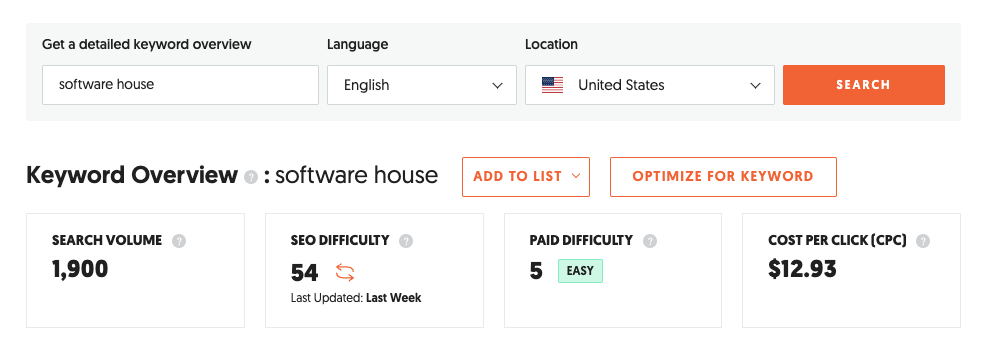
Source: https://neilpatel.com/ubersuggest/
- Search Volume = 1 900 – on average, in the last 12 months, in the United States, the keyword “software house” was searched by 1,900 people.
- SEO Difficulty = 54 – the difficulty of organic positioning for this keyword is 54 out of 100.
- Paid Difficulty = 5 – the difficulty of paid positioning (PPC — pay per click), is 5 out of 100.
- Cost Per Click (CPC) = $12.93 – the cost of a page entry from a paid PPC ad – Google Ads – clicks is $12.93.
Which means that in order for 100 people to enter their website from this ad, they have to pay $ 1,293, and we do not know if someone from such a small number will fill out a contact form.
Therefore, according to the assumptions of this strategy, it is necessary to “go deeper”. Where customers do not have a “high shopping temperature” (i.e. they know what they want to buy, they have the budget for it and they are looking for the right product for them).
The purchasing decision process consists of three stages:
- Cold customers — I don’t know if I need anything.
- I run a business — a company — we manufacture windows and I don’t know that there is software on the market that will help me and my crew save a lot of time. I do not know that such software is called ERP. I get up in the morning without that headache.
- Lukewarm customers — I know I have a problem, I’m looking for a solution.
- It bothers me a lot that everything in my company takes place “on a piece of paper”, I want to optimize this process. I’m looking for a solution on the internet. I enter phrases: “how can you automate work in the company”.
- Warm customers – I know I have a problem and I know I want to solve it with product X.
- I have a budget prepared for the purchase of ERP software, I compare several competing solutions.
As I wrote earlier – most companies are looking for a competitive advantage, trying to acquire customers with “high shopping temperature”. Who know what they want. The thing is that a good marketing strategy is one that does not give competition a chance.
Therefore, according to the assumptions of this strategy, it is also worth influencing customers: cold and summer. And not only those with “high shopping temperature”, where the price of customer acquisition is the highest.
How to run a Lead Heating strategy?
Click the image below to zoom in.
Stage 1 — Cold Sales Funnel — I don’t know if I need anything?
- It starts with advertising campaigns that aim to inform the recipient about our offer:
- DM — Direct Messages, via Social Media. For example, via LinkedIn and Facebook. Here you can use the Expandi solution: https://expandi.io/
- PPC — Pay Per Click campaign — Pay per click, it can be: Google Ads, Facebook Ads and others.
- Content Marketing — Posting content that interests your audience across social media.
- Then we encourage them to download the “Lead Magnet”.
- This is interesting material for potential customers who do not yet know that they may need something. Most often it is: report, video, pdf, etc.
- Users who have expressed interest in the Lead Magnet go to the email database and are remarketing. Automated emails are sent to them, or they are sent a picture advertisement that appears in various places when they browse the Internet.
- In addition, right after the sign-up, potential customers are offered the Godfather’s Offer — that is, one that they “cannot refuse”. Very attractive, tailored to their needs and current for a certain time, e.g. 72 hours.
- The database of potential customers is saved and then used – “heated further” – in the Warm Sales Funnel.
Stage 2 — Warm Sales Funnel — I know I have a problem
- First, a email and remarketing database is downloaded and encouraged to read articles that solve specific customer problems.
- In addition, channels are used to encourage users to read the same articles:
- Content marketing — create a publication and share it in the recipient’s environment.
- PPC — payment your ad.
- DM — direct messages
- Google Ads Search — here the keyword is the customer’s attempt to find a specific problem (e.g. the best ERP systems for manufacturing companies), and redirect to the article (with the same title).
- Articles are equipped with CTA (Call To Action), which can be an incentive to talk to an expert.
- The database of potential customers is saved and then used – “heated further” – in the Sales Hot Funnel.
Stage 3 – Hot Sales Funnel – I am looking for a company that will solve my problem
- As before, the customer base is downloaded from the Warm Sales Funnel and encouraged to familiarize themselves with individual products (to enter the product pages where the product is presented).
- The same marketing channels are used to encourage potential customers to visit individual product pages.
- So we follow the same strategy that most companies pursue. Except that we are: better recognized on the market, we accompany the client from the moment when he did not know yet that he could solve his problem.
Marketing Strategy: Lead Heating will work best:
- For companies with a verified market hypothesis. Where it is known that there is a product-market fit.
- Its proper implementation requires very large amounts of money and time.
- In the long run, it is one of the best strategies to achieve the position of market leader. If carried out correctly, it is extremely difficult to compete with it.
Marketing Strategy: Sniper Landing Page
Creating separate campaigns leading to a Landing Page advertising a single product or service.
How to run a Sniper Landing Page strategy?
The strategy is implemented in stages:
- Analysis of market niches.
- With software like UberSuggest or semrush, we can analyze where a market niche is in our market.
- It is especially important here to find keywords that have a large volume (average monthly number of searches), but a relatively small CPC (cost per click in Google Ads), or relatively easy to find yourself on the first page in organic search results.
- Preparation of USP for each niche.
- Searching for answers to the question why, our product/service is unique and valuable in our industry.
- Preparing landing pages and connecting marketing channels to them.
- That is, choosing where we want to promote them, e.g. social media, PPC, email marketing, etc.
The Sniper Landing Page strategy will work best:
- For industries with very high competition, where conducting advertising activities in a highly competitive market is unprofitable. It is worth considering whether it is possible to occupy a very specific niche. According to the principle:
- CRM System – price $1000
- CRM System for Healthcare Companies – price $2000
- CRM system for medical companies specializing in X-ray – price $5000
- It can also be used to search for a product — market fit. Especially in the case of SaaS applications, we can create several landing pages that will tell us where to best advertise our solution, what marketing channel.
Find out more
Audit
and marketing plan
An audit and marketing plan is the best way to start marketing activities
External marketing department
In the price of “Digital Marketing Manager” we support all customer acquisition channels
Strategy
Session
Make an appointment for a free strategy session – let’s determine together what you need to acquire customers




























Selected projects
Billon Group: Cost Per Lead = 43 USD
Together with Billon Group, we created a promotional campaign on LinkedIn (segment: c-level ppl, companies from Singapore). The campaign objectives were achieved in the second month of the promotion.
Cloudica: Cost Per Lead = 15 USD
For Cloudica, we have developed a new brand communication system – website and launched new profitable customer acquisition channels (Google Ads, LinkedIn DM, Content Marketing, SEO).
What do customers say about us?
“I am very impressed by the knowledge they have in the field of customer acquisition for IT companies. With 0101marketing, our customer acquisition channels have increased ROAS and thus the number of leads generated.”
Katarzyna Kazimierczak-MrowińskaCEO, Authenteq
“0101marketing proposed a marketing plan that quickly yielded satisfactory results. The team hit the nail on the head of the preferences and needs of ad-hoc customers. Overall, their competence in this area was crucial to the success of this cooperation.”
Adam KoteckiCEO, Cloudica
“We like how they iteratively refine the marketing process. The LinkedIn campaign received positive feedback from the messages sent. An effective approach to our marketing has provided reliable results.”
Norbert KozłowskiCo-Owner, ARC Software
“We like how they iteratively refine the marketing process. The LinkedIn campaign received positive feedback from the messages sent. An effective approach to our marketing has provided reliable results.”
Eryk GąszczykCEO, spinbits.io

